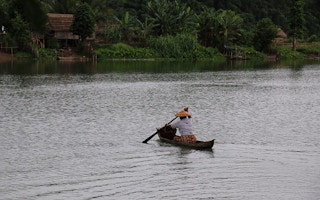From the snow-capped mountains of Tibet, the Salween rushes through steep gorges in Yunnan Province and flows through four of Myanmar’s ethnic states before emptying into the Andaman Sea.
With dams on hold upstream, Yunnan’s provincial chief Li Jiheng expressed support in 2016 for a national park to stimulate this region’s tourism in the upper Salween (the Nu River) which already attracts many visitors to the ‘Three Parallel Rivers’ World Heritage site. Although Li Jiheng was recently replaced by Chen Hao, it is hoped that the dams will remain suspended.
Paul Sein Twa, chairman of the Karen Environmental and Social Action Network (KESAN) commented, “If China does not build dams on the Salween, Burma also should not build any. They should work together. This river should flow freely starting from the river’s source to its mouth”.
The National League of Democracy (NLD) government led by Aung San Suu Kyi certainly appears to be working closely with China but not in the direction of protecting the Salween.
Aung San Suu Kyi selected China for her first overseas state visit. She also appears to be attentive to the concerns of their hydropower corporations lobbying to build dams in Myanmar. But Aung San Suu Kyi needs to listen to other Chinese voices.
She has not had the opportunity to hear other Chinese voices such as the award-winning environmentalist Yu Xiaogang, founder of the Yunnan-based NGO Green Watershed.
“
We expected the new government to declare a moratorium on Salween dams. Shan people are surprised that the new government does not respect our ethnic rights.
Sai Khur Hseng, environmentalist, Sapawa
Speaking about the Kunlong dam in Myanmar, Yu told this correspondent, “I heard this dam will be built in the border area on the Myanmar side. I am very concerned this same area is in the earthquake zone that can produce an earthquake of 8.00 degrees [on the Richter scale].
So if the Chinese government stop dams, then I think Myanmar, the downstream country, must consider this earthquake risk to their people.”
Hopes dashed by new democratic regime
The hopes of ethnic minorities in Myanmar, who depend on the undammed Salween River (also known as the Thanlwin) for their cultural and economic survival, have been dashed by the new government’s approval of hydropower dam projects inherited from the previous military regimes.
Aung San Suu Kyi, a pro-democracy icon during the long years of military rule, led the NLD to a landslide victory in the 2015 election, promising a new era of democratisation and respect for human rights. The election manifesto of the NLD included a commitment to a new energy policy and warned that, “The construction of the large dams required for the production of hydropower causes major environmental harm.”
But while the controversial Myitsone dam on the Irrawaddy has been suspended pending review by a special government commission, plans for a cascade of dams on the Salween are still moving ahead. Without first carrying out any kind of review of these environmental impacts, U Htein Lwin, permanent secretary at the Ministry of Electric Power, announced on 12 August 2016 that hydropower projects would go ahead on the Salween during a press conference to mark the government’s first 100 days in power.
Campaigners say the dams will displace thousands of people and threaten the fragile peace process. Nonetheless the current government’s focus is on access to energy for the general population. Only about 30 per cent of the population connected to the national electricity grid and the NLD desperately wants to change that number.
But energy experts say Chinese and Thai backed dam projects on the Salween do not seriously address the domestic energy deficit. Two of the largest dams: the 7,100 MW Mong Ton in Shan State and the 1,360 MW Hat Gyi in Karen State will deliver 90 per cent of electricity generated to China and Thailand according to the MOU’s signed with Chinese companies such as Sino-hydro, the Three Gorges Corporation and EGATI (Thailand’s Electricity Commission).
Only 10 per cent of electricity is assigned to the country that needs it most – Myanmar. Moreover with increasing irregularity of water flows due to climate change and melting glaciers, the energy flow from these dams will also be affected.
Civil society and ethnic groups are advocating green energy alternatives in place of mega-dams. Aung Myint, General Secretary of the Renewable Energy Association of Myanmar (REAM) reports that it would be cheaper and faster to install electricity outside Myanmar’s very weak national grid.
Decentralised mini grids can be easily installed either for small hydropower or solar in remote areas. These could form part of a new energy policy harnessing solar and wind-power as the fastest options to supply rural communities starved of electricity.
Environmental destruction and earthquake risks
Shan environmentalist Sai Khur Hseng from the NGO Sapawa told thethirdpole, “We expected the new government to declare a moratorium on Salween dams. Shan people are surprised that the new government does not respect our ethnic rights.”
The free-flowing Salween is the last important undammed river in Asia. Endangered species including tigers and clouded leopards can still be found in remote parts of Myanmar’s Karen State where the river flows.
This story was published with permission from The Third Pole. Read the full story.

















